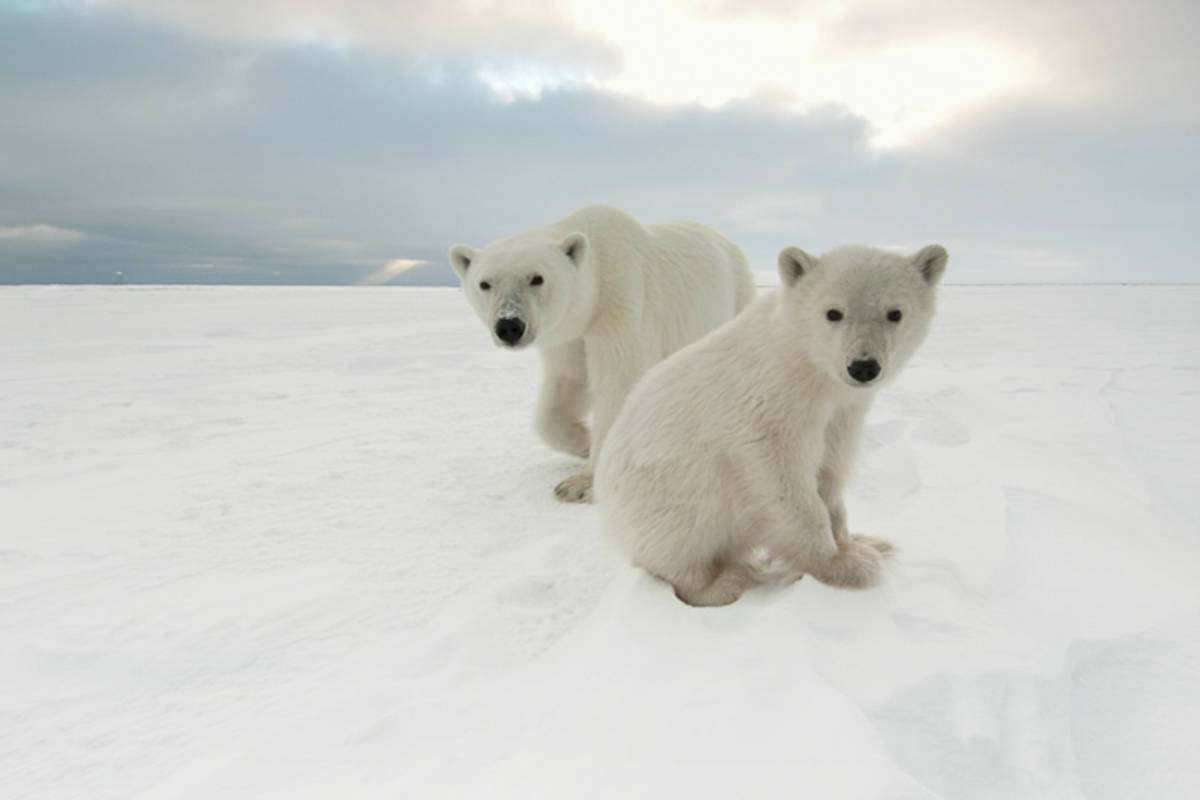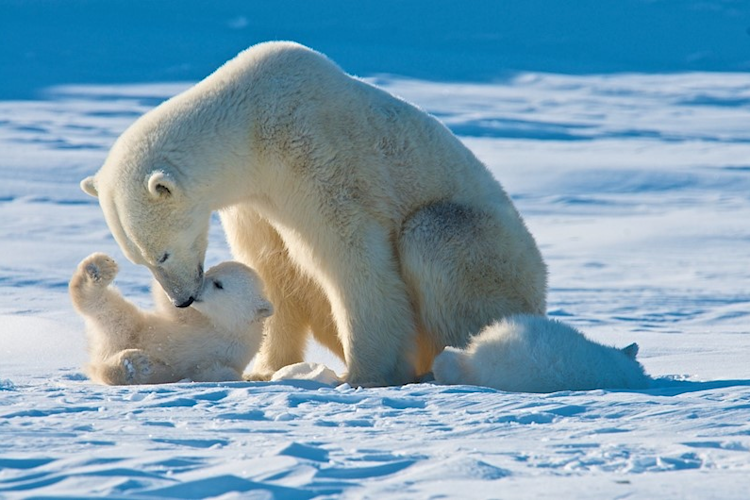We’re excited to introduce our Photography Ambassador Program! At Polar Bears International, our roots began in photography, and it remains at the core of our identity. Photography is a crucial tool that helps us share the stories of polar bears and their Arctic habitat. With so many skilled photographers and storytellers in the field today, we’re partnering with a few talented individuals to help us bring the North to life for our polar bear community. Keep an eye out for their incredible visuals and stories from the field.
The first ambassador we’d like to introduce is Daniel J. Cox of Natural Exposures. Daniel has been involved with Polar Bears International for over 15 years and has been essential in growing the organization to what it is today. He is not only a platinum sponsor, but also a trusted advisor, world-renowned photographer, and dear friend. In collaboration with Polar Bears International, Daniel created the Arctic Documentary Project to document Arctic animals and their ecosystems and continues to produce multimedia materials on some of the world’s leading Arctic scientists as they conduct field work.
We are honored to be launching our new group of Photography Ambassadors with Daniel. Daniel’s photographs have graced the cover of National Geographic and numerous other publications, as well as our educational materials for nearly two decades. Daniel’s imagery and deep love of the Arctic has helped stir a passion for polar bear conservation in his work and travels both independently and in collaboration with Polar Bears International. Daniel has truly helped make our organization what it is today.
We talked with Daniel about his life’s work and his passion for the Arctic.
Q: When did you start photographing Arctic wildlife?
My first trip to the Arctic was with Dan Guravich, who was the original founder of what is today called Polar Bears International. Dan was leading photo groups to a small inlet on Hudson Bay known as Wager Bay. My main goal was to photograph polar bears, but I quickly realized there was much more to the Arctic than just polar bears. My boyhood home north of Duluth, Minnesota, gave me the ability to cope with cold temperatures. Feeling comfortable in frigid conditions, along with an adventurous spirit and curiosity about wildlife and nature, it seemed only natural to explore the far reaches of the North American continent.
Q: What drew you to photographing polar bears?
Bears have always been an interest of mine. It began on my family's hobby farm in northern Minnesota. Regularly I would see black bears pass through the yard. To experience such a big, beautiful animal at close distances inspired my love and respect for black bears and eventually all bears. Since I was relatively close to Canada and south of Hudson Bay, polar bears seemed like a natural extension of my desire to know more about this inspirational group of animals. As a young photographer trying to make a living photographing wildlife, it also helped that many people admire and appreciate seeing pictures of polar bears. This combination of life interests led me to Dan Guravich and the High Arctic.
Q: What is your favorite part about photographing polar bears?
For me, it's not just about the bears; it's as much about the wilderness they inhabit. Polar bears live in the coldest climates, and because of that, there are few people. Of course, there are Indigenous people, but compared to the many places black and grizzly bears live, polar bears are mostly free from human encroachment. However, things are changing. Since the Arctic is much warmer than it used to be, polar bears are now spending substantially more time on land. For an animal that evolved to live on ice, this change in circumstances presents many challenges for humans and bears.
Q: What are some of the challenges of photographing in the Arctic?
The number one challenge to documenting the Arctic is the cost of access. Getting to the remote areas of the Far North is extremely expensive. This reality is why I started the Arctic Documentary Project (ADP). Documenting the Arctic animals and the world they live in became impossible to finance on my own. I needed a way to fund the photo projects PBI depends on. At one time, the pictures and videos I donated to PBI came from my assignments with publications. But we all know what happened to the world of print. It's a shell of its former self. To continue this critical mission, the Arctic Documentary Project was born. PBI's roots run deep in the world of visual communication. Dan Guravich, the original founder, was a photographer. Robert Buchanan, who reinvented the organization when Dan passed away, was also a photographer. Visual communications have always been vital for inspiring people to care about polar bears.
Q: How has the Arctic (and the polar bears' habitat) changed since you began documenting the ecosystem through photography?
My first trip to Hudson Bay to photograph polar bears was in 1987. During the '80s and '90s the most optimum time for polar bear photography was the first two weeks in November. In those years, it was most common for the bay to freeze somewhere close to November 15. Once the ice formed, the bears would be gone. Today, the bay sometimes doesn't freeze until far into December. During the first two decades of my work on Hudson Bay, we would pull the Tundra Buggy Lodge down the coast to Cape Churchill, where I would spend approximately two weeks documenting polar bears. To make our way to Cape Churchill required the water's edge to be frozen to allow safe passage. Today we have to evaluate whether or not it freezes hard enough to make that journey. It is no longer predictable or reliable.
Q: How did you become involved with Polar Bears International?
During the late '80s and throughout the '90s, I spent almost every fall visiting Cape Churchill to document the annual polar bear congregation on the shores of Hudson Bay. During those years, I met my good friend Robert Buchanan who also enjoyed photographing polar bears. Our friendship and Robert's eventual leadership at Polar Bears International inspired me to become more active with PBI. Robert knew that quality multimedia assets were essential for inspiring people to take an interest in the polar bear's plight. Our mutual commitment to getting the word out solidified our goals as well as our friendship.
Q: Do you have any favorite moments or funny stories from the field to share?
My first trip to Wager Bay was a bit more harrowing than I anticipated. We had been searching for polar bears for several days. There were still substantial amounts of ice on the bay with lots of cracks and open leads. Getting around was a challenge for our small boat. The shifting ice presented potential danger from the possibility of open water leads closing and blocking our ability to get back to the lodge. Since we hadn't seen a single bear our entire week, our guides decided to press farther into the icy waters of the bay. As the day wore on, the large open cracks of icy water that allowed passage farther up the bay began to close. It wasn't long before the watery path back to the lodge had turned to ice.
As the day wore on, it was apparent we wouldn't be getting back to our lodge, and Plan B was in order. We found a small island that would have to do as our place of refuge for the night. Thankfully we had radio contact with the lodge, and a talented pilot buzzed the island, dropping food, blankets, and supplies in what resembled a bombing run. I look back on it now, and it all seems so benign. But several people in our group came close to losing their minds over the anxiety of the whole affair.
It didn't bother me. The island was soft and comfy, with lots of spongy, mossy tundra. The wind was still, and it was a relatively warm summer evening. I found a comfortable depression on the backside of a hill and settled in for the night. The polar bears we had hoped to see were almost nonexistent, so the chance of one visiting in the night was remote. I tucked in behind the hill, curled up in my parka, and fell sound asleep. The following day I woke to water all around and a cleared passage back to the lodge.
















